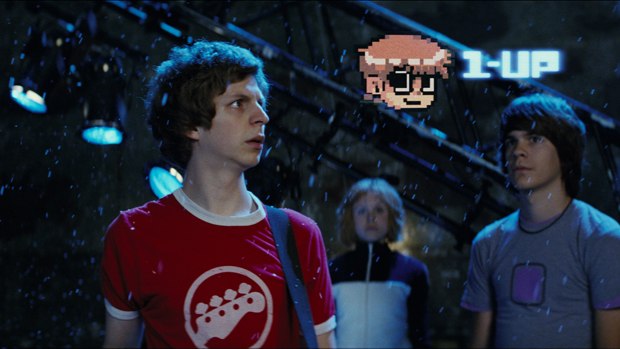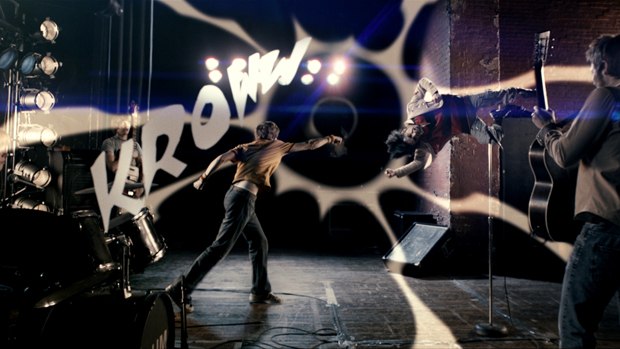Double Negative and Mr. X describe the vfx vibe of Edgar Wright's action romance.
With Scott Pilgrim vs. the World, director Edgar Wright (Hot Fuzz, Shaun of the Dead) does a mash-up of videogames and anime, but with a firmer grounding in reality and photography than, say, Speed Racer.
Based on the cult comic book by Bryan Lee O'Malley, the film follows Toronto-based hipster Scott Pilgrim (Michael Cera), his band Sex bob-omb, and charts his efforts to win the heart of the elusive girl of his dreams Ramona Flowers (Mary Elizabeth Winstead). But to win Ramona's heart, Scott he must defeat her seven evil-ex boyfriends in combat, with each fight more spectacular than the last.
"The best way to describe the world of Scott Pilgrim vs. the World is that it's a normal world of a normal young man filtered through his overactive imagination," Wright suggests. "Bryan Lee O'Malley describes Scott as the hero of the movie in his own head. My goal is to make that very movie. The emotions and interactions throughout the film are infused with the mass media that this generation has grown up with; not just in music, film and animation, but in over 30 years of video games. Our characters' life experience is completely governed by the ridiculous amount of time they've spent with their Nintendo consoles. For the twentysomething characters in the film, the incidental music for Zelda is as resonant as nursery rhymes.
Wright's ambitious vision proved to be quite the vfx challenge for Double Negative in London and Mr. X in Toronto, resulting in 1,200 shots. Dneg's Frazer Churchill served as overall visual effects supervisor, Andrew Whitehurst was Dneg's CG supervisor and Rupert Porter was vfx producer. Aaron Weintraub served as visual effects supervisor for Mr. X.
"It's got this unique look and this design proposition, which is, how to translate O' Malley's artwork with Edgar's sensibility onto film," says Churchill. " The trick was to fuse the notion of the '80s Nintendo console and other graphical ideas. We would have to make his graphics photographic and visualize the extremely stylized fight sequences, all of which were based in a hyper-real altered reality. The big design question was how to keep the spirit of the comic while working with live-action photography.
"During the story, Scott battles a Bevy of winged demon hipster chicks, has a "bass off" with a levitating vegan, battles the Katanyagi Twins and their double headed snow dragon by creating a green-eyed Sound Yeti from his amplifiers," Churchill continues. "Peoples' sentences are punctuated by on-screen comic book text boxes; peoples' actions have visible sound effects graphics, which obey photographic depth of field. Musical sound waves are visible and sometimes turn into creatures and people have a habit of bursting into showers of coins."
In other words, it's about the wildest cinematic ride since Speed Racer.
"Edgar and his brother Oscar (the concept designer) explained their vision for the film and showed us a whole host of references from FMV game sequences, old and new Streetfighter, Tekken and the like through to Japanese animation: Naruto, Fooly Cooly, Samurai Jack, Afro Samurai. We reviewed many hours of footage, while they explained in detail how they saw the aesthetic of the film.
"There was a delicate balance to be trodden, because while they wanted the sequences to be stylized they didn't want them to be too stylized: they wanted everything to have a firm basis in reality and photography. They cited Speed Racer as an example of the aesthetic going too far for them.
"Working closely with Edgar, DP Bill [Pope] and Production Designer Marcus [Rowland], we went through every story board to establish how we'd realize each frame: we'd identify which shots we thought would be slow-motion, phantom digital, film, VistaVision or regular spherical; how much set to build, how much set-extension, which characters would be shot in bluescreen or digital. Each frame in SP is a marriage of physical & digital techniques, and we were able to lock down our approaches early on thanks to the extensive storyboarding & test shooting that had already been done."
The first fight sequence with Patel (Satya Bhabha), which was partially worked on as a test, is obviously an attention grabber. When it begins you see Patel burst through the ceiling and the proportions of the room stretch and you have speed lines and on screen graphic sound effects (inspired by the Batman TV series) and the film reaches a new level. It's full of kung fu fighting and manga and Bollywood references.
"The whole sequence was shot using a combination of bluescreen photography and in situ on-set photography," Churchill continues. "Patel's flying pose was shot on a parallelogram rig against blue with an interactive light sequence rolling over him and wind machine to create movement. The interactive light was created by a series of programmed par cans and a rolling mirror.
"Bryan's comics are filled with these onomatopoeic effects and when Patel gets punched and the word 'Krowww' appears on screen, Scott gets flung hundreds of yards across the set and the word 'Whip' appears behind him. Edgar wanted these graphics to feel integrated with the photography, so we'd take graphics directly from the comic book track them into the shots and composite them with the correct depth of field for their position in space, we'd give them a subtle translucency so the lights in the shot would shine through them, they'd have subtle coloration imperfections along their edges, a chromatic aberration just to give them photographic attributes. "
For a change, Toronto gets to represent Toronto, and environments were crucial. "The idea was that the look of the exteriors in the film should be somewhere between a comic book and reality," Churchill suggests. "We took location photography and removed extraneous detail like road signs, electrical wires and a lot of detail from the trees while at the same time 'smoothing' snow detail, the result was a 'simplified' exterior shot that had something of the feel of the comic but with its feet firmly planted in photographic reality, this delicate balance."
This was done by Mr. X of Toronto. "We went along for the ride with the designer and shot stills that precisely matched the angle and composition of the panels in the books," explains Mr. X's Weintraub."From there, we put together a package that showed each of the locations with varying levels of simplification ranging from the photograph all the way to Bryan's cartoony style, and with Edgar's guidance, netted out somewhere in between.
For this preliminary design work, because it was only on stills, we worked almost exclusively in Photoshop. We took the original photographs and painted successive layers of removing more and more detail, flattening out colors and surfaces, until finally we arrived at the graphic style of the books.
"In addition to the simplification, we also added CG snow piles, aerial snow and overall 'de-greening' of the environment. Most of the environment simplification shots were done with a 2.5D projected matte painting approach. We first matchmoved the shots using mostly PFTrack, but also some boujou and 3D Equalizer, and modeled stand-in geo for the shots in Maya, representing buildings, cars and roads. If the shot was locked off or otherwise essentially shot from a single perspective, we would paint a single layered painting that covered all the areas where simplification was required. If it was a moving camera, we would either create a larger oversized painting that encompassed the entire camera move (useful for mainly nodal pans), or select keyframes throughout the shot for a multiple painting approach. In Nuke, the various layers in the painting were projected onto the stand-in geo from the matchmove, and then everything was blended together in the final comp.
"For the falling snow, we developed a highly controllable and directable 3D snow particle system in Houdini that could be tuned not only for amount, speed, and wind acting on the snow, but also for the character and the style of it."
For the final confrontation with Ramona's arch evil-ex Gideon (Jason Schwartzman) at the Chaos Theatre, Scott pulls a flaming sword from his chest and fights a horde of charging hipsters.
The actor wielded a plexiglass sword filled with red LEDs so that he had interactive light cast on him representing the flames; it also gave great reference for the level of motion blur the CG flaming sword should have. He had a cut off version of the sword allowing him to swipe "through" his attackers, and a full-length version for shots where his strikes don't connect. Each time Scott strikes one of the hipsters with his sword they burst into a shower of coins. The coin explosions were created in Maya DNB and rendered in RenderMan; the CG flames again were created in Squirt; the plexiglass sword was replaced with a CG metal blade, which, in turn, was engulfed in CG flames. The flames were overseen by Mick Harper with assistance from Federico Fasselini. Jim Steel, Shahin Toosi & Cleve Zhu oversaw the compositing effort.
"Ultimately, the vfx play a key role in creating the fun, energy and insane 'never seen before' surprises that characterize the film," Churchill concludes.
Bill Desowitz is senior editor of AWN & VFXWorld.











